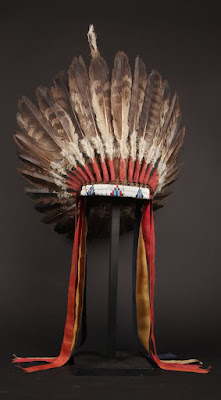Headdresses
Roach Headdresses
Also called porcupine roaches or artificial roaches, these were the most widely
used headdress amongst Native American tribes. They are made of stiff animal hair such as porcupine guard hair, moose hair, and deer's tail hair that is attached to a bone hair ornament or leather base so that it stands upright. In some tribes and most commonly today, they are attached to leather headbands or thongs and worn over long hair or braids. Some men wore their hair in a mohawk fashion and attached the animal hair to their real hair.
Roach headdresses were worn only by male warriors. Some tribes wore them into battle,
while some others used them as formal ceremony garb. Other tribes used them strictly as dance and sport regalia.
Warbonnets
The feathers of all three types of warbonnet shown are from a golden eagle, each one
earned through an act of bravery. A feather was sometimes dyed red to commemorate a particular deed. They were purely ceremonial, not exactly practical battle wear, and wornn by
male chiefs and warriors. In the 1800s, when many Native American tribes were forced to relocate to Oklahoma, tribes that had never seen the warbonnets before began wearing them, though
they had different connotations; they more of a fashion and power statement than
a sign of bravery.
There were several types of warbonnet, listed in order of appearance:
straight-up, halo, and trailer.
Horned Warbonnets
Also called buffalo headdresses, these headdresses have similar meaning to
the feathered warbonnets, though they were much less common. They were helmets made of
buffalo hide with buffalo horns attached, sometimes with furs and feathers attached.
Fewer tribes wore horned warbonnets, and those men that did were from
specific clans or accomplished specific deeds.
Otter Fur Turbans
Also known as otter-skin caps, these are ceremonial headdresses worn by men in certain
prarie and Southern Plains tribes, such as Potawatomi, Pawnee, and Osage. They are round
and made of otter fur with the otter's tail either hanging down the back or jutting
off to the side. They were often decorated with paint and beading to symbolize the owner's
war honors, and a chief and his descendants attached eagle feathers to the back. They were
worn at ceremonies and other solemn occasions, still occasionally worn today.
Clothing
Clothing was made of tanned animal skins, most commonly deer or elk skins, and sometimes
antelope and mountain sheep. They were often decorated with special designs of porcupines and
beads. In the cold winter months and for men's public appearances, buffalo robes
were very important. They were made of a large piece of skin with the fur still on.
The side without fur was often decorated with designs that were painted or with porcupine
quills that were sewn in place, depicting family history or war or hunting exploits.
Women wore skin dresses, while men wore a shirt, breechclout, and leggings. It was
embellished with quillwork, elk teeth, beadwork, and sometimes hair and fur.





















No comments:
Post a Comment